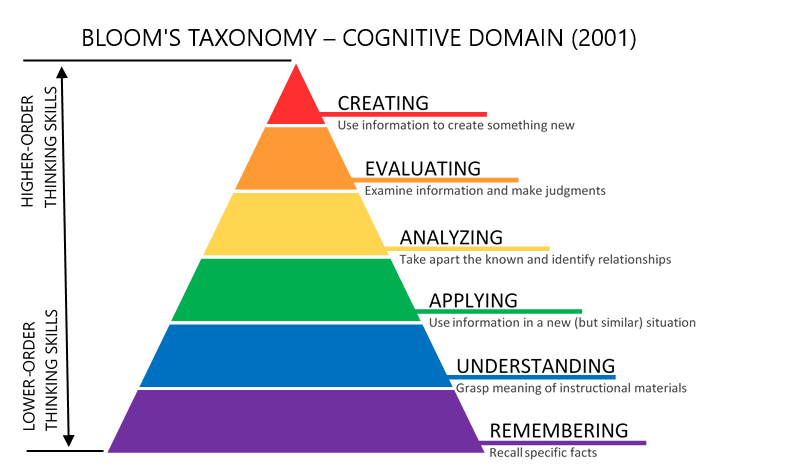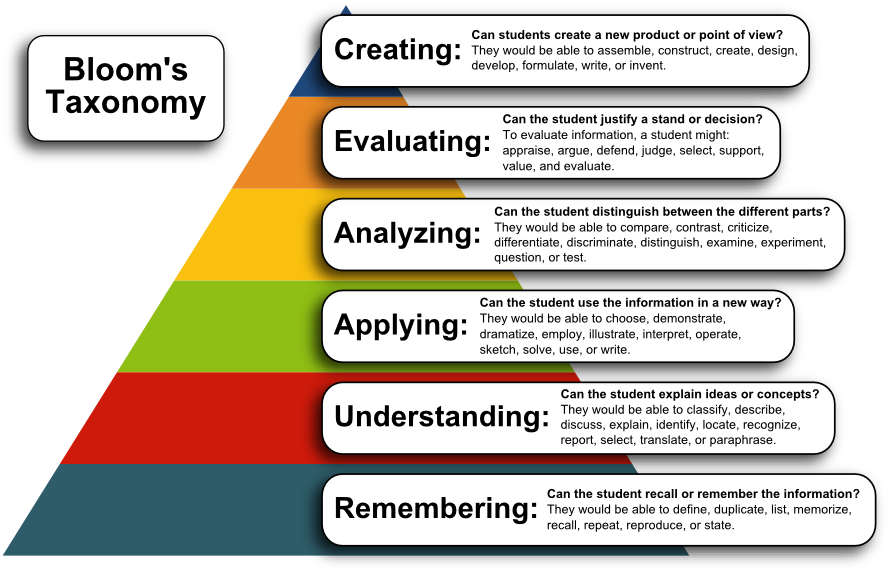The Benefits of Bloom's Taxonomy
Bloom’s Taxonomy should be in your daily toolkit if you’re a lifelong learner!
Bloom’s Taxonomy remains one of education’s most powerful and well known evaluation frameworks.
Originally developed by Benjamin Bloom in 1956 and revised in 2001, Bloom’s Taxonomy has revolutionized how we approach teaching, learning, and assessment across disciplines.
What is Bloom’s Taxonomy?
The framework organizes thinking skills into six progressive levels: Remember, Understand, Apply, Analyze, Evaluate, and Create. This structure provides immediate, practical benefits for educators and learners alike.
 Source: Information Technology University of Florida
Source: Information Technology University of Florida
Have You Considered Your Learning Objectives?
Bloom’s helps you define crystal-clear learning objectives. Instead of vague goals like “students will learn about basic data structures,” Bloom’s encourages specific outcomes: “students will compare the efficiency of for sets vs. lists when processing large datasets in Python.” This precision helps students understand expectations and makes assessment more straightforward.
Organize your Learning
Scaffold your learning! Reduce cognitive overwhelm and ensure that you develop prerequisite skills for complex analysis and creative work.
Traditional assessments often test primarily recall and comprehension. Bloom’s pushes you to diversify assessment strategies, incorporating opportunities for students to analyze case studies, evaluate theories, or create original solutions, providing a complete picture of student learning! Besides recall and comprehension, Bloom’s encourages everyday learners to apply, analyze, evaluate, and create with their recently acquired knowledge.
Enhance Critical Thinking
Cultivate critical thinking with Bloom’s in everyday life! Consistently encounter tasks across all cognitive levels, they internalize these thinking patterns and begin asking deeper questions naturally.
Start considering your everyday learning journey with Bloom’s: Remember, Understand, Apply, Analyze, Evaluate, and Create!
 Source: University of Wisconsin, Madison
Source: University of Wisconsin, Madison
Verbs and Product-Outcomes based on Bloom’s Taxonomy
Adapted from “Verbs and Products/Outcomes Based on the Six Levels of Bloom’s Revised Taxonomy” by Northern Illinois University Center for Innovative Teaching and Learning. (2020). Bloom’s taxonomy. In Instructional guide for university faculty and teaching assistants. Retrieved from https://www.niu.edu/citl/resources/guides/instructional-guide/blooms-taxonomy.shtml, Last accessed August 21, 2025.
| Level of Thinking | Concept | Verbs |
|---|---|---|
| Creating | Making Something New | change, combine, compare, compose, construct, create, design, devise, formulate, generate, hypothesize, imagine, improve, invent, plan, predict, propose |
| Evaluating | Making Judgments Based on Criteria | argue, appraise, assess, check, debate, decide, defend, determine, dispute, editorialize, judge, justify, prioritize, rate, recommend, select, support, verify |
| Analyzing | Distinguishing Different Parts of a Whole | advertise, analyze, appraise, attribute, categorize, compare, contrast, differentiate, distinguish, examine, identify, infer, investigate, organize, outline, separate, sequence, test |
| Applying | Using Information in New Situations | classify, construct, complete, demonstrate, dramatize, examine, execute, illustrate, implement, practice, show, solve, use |
| Understanding | Explaining Information and Concepts | calculate, compare, define, describe, discuss, distinguish, expand, explain, identify, interpret, locate, outline, predict, report, restate, translate |
| Remembering | Recalling or Recognizing Information | describe, duplicate, find, list, locate, name, recall, recognize, reproduce, state, tell, underline, write |
Interesting Resources for Everyday Learners
Northern Illinois University Center for Innovative Teaching and Learning. (2020). Bloom’s taxonomy. In Instructional guide for university faculty and teaching assistants. Retrieved from https://www.niu.edu/citl/resources/guides/instructional-guide/blooms-taxonomy.shtml, Last accessed August 21, 2025.
Fort Hays State University, Teaching, Innovation and Learning Technologies. (2023). The Revised Bloom’s Taxonomy as a Framework for Writing Learning Objectives. Retrieved from https://tigerlearn.fhsu.edu/the-revised-blooms-taxonomy-as-a-framework-for-writing-learning-objectives/, Last accessed August 21, 2025.
University of Wisconsin, Madison, Division of Continuing Studies. (2016). How can Bloom’s Taxonomy Help with Writing Learning Objectives?. Retrieved from https://courses.dcs.wisc.edu/design-teaching/PlanDesign_Fall2016/2-Online-Course-Design/2_Learning-Objectives-Alignment/6_objectives_blooms-taxonomy.html, Last accessed August 21, 2025.